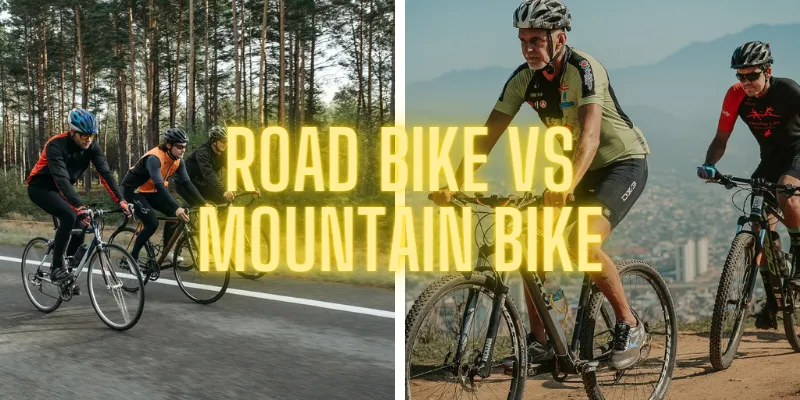The differences between road and mountain bikes stem from what you’d be using the bikes for.
Road bikes are designed to be used on paved surfaces; so cycle paths, streets, country lanes, etc. Mountain bikes, on the other hand, are designed for off-road riding, so effectively the opposite of what road bikes are designed for.
The ‘mountain bike vs road bike’ debate is a pretty common one in the biking community. In this article, we’ll be making the differences between the two types of bikes very clear; if you’re trying to decide between road bikes and mountain bikes, you should have your answer at the end of this article.
What’s Inside
What are road bikes | Pros & cons | What are mountain bikes | Pros & cons | Road bike vs MTB | Road bike vs MTB comparison table | Which is best
What Are Road Bikes?
Road bikes are bikes made for speed along paved surfaces; some call them racing bikes. These bikes are designed to allow riders to cycle quickly on roads.

Types Of Road Bikes
Although road bikes are a type of bike; they have a continuously growing list of subtypes, each with its slight modification or difference in use that makes such a variance necessary.
Many of these types of road bikes overlap in attributes and functions. Basically, these types aren’t rigid and can be used for things outside their specification.
These are some types of road bikes:
- Endurance Road Bike
An endurance bike is a bike that offers the lightweight benefits of a standard road bike but focuses on comfort.
Endurance bikes are designed for people that will be riding the bike for extended periods; hence it needs to be as comfortable as possible. The riding position of an endurance bike is more upright than other road bikes so that you can be comfortable all day long.

This is the perfect bike to get if you’re practising for marathons and really long rides.
- Aero Road Bike
This is a road bike that is aerodynamically focused; this basically means that the parts of the bike are shaped in a bid to reduce wind resistance.
The general idea is that due to the shape, the bike can cut through the wind when riding. These bikes have wind tunnels that increase the potential speed of the bike with no added effort.
Aero road bikes are slightly heavier than the traditional road bike because parts of it are made of carbon fibre for aerodynamic shaping; this doesn’t matter when riding on a flat surface but may become relevant if you’re going uphill.
- Gravel Bike
These bikes are a more recent addition to the world of road biking. Gravel bikes can handle certain off-road terrain like tracks and trails whilst still being able to cover long distances relatively quickly.

Gravel bikes are unique because they are comfortable enough for you to ride for long periods of the day and also allow you to tackle rather difficult terrain. However, for the most challenging terrain, you’ll still need a mountain bike.
The downside of the versatility of the gravel bike is a slight reduction in speed, but if you weigh the positives and negatives, it is worth getting for most people.
- Commuter Bike
The commuter road bikes were designed for durability and comfort. Commuter bikes are used every day by people commuting to and from work or school.
People regularly commute irrespective of the weather conditions, so these bikes are designed to withstand harsh weather conditions over time; they are made to last long effectively.
They also have a short reach to allow the rider to maintain an upright position when cycling; this ensures that the rider is comfortable.
Suggested post: Best road bikes under $500
Advantages Of Road Bikes

- Road bikes are significantly lighter than mountain bikes because they were designed with speed in mind.
- Road bikes are more aerodynamic.
- Road bikes allow you to ride in multiple hand positions, which is good for the overall biking experience.
- Road bikes are more efficient than mountain bikes; it takes less energy to ride a road bike than a mountain bike. This is because the bike is lighter and doesn’t have heavy suspension systems.
- Road bikes are faster than mountain bikes; you can accelerate faster and reach higher top speeds with a road bike when compared to a mountain bike.
- Road biking is more accessible to most people because more people live near roads and paved surfaces than near mountains and rugged regions.
- Road biking is a brilliant cardio workout; regular cycling will keep you in the optimum heart rate zone
- Road bikes can pass through narrower gaps because they are slimmer.
Recommended reading: Men’s vs Women’s Bikes
Disadvantages Of Road Bikes
- Road bikes offer less traction because its smaller surface area leads to reduced friction when riding.
- You can’t ride in as many places with a road bike as you can with a mountain bike; you are pretty much limited to riding on paved surfaces.
- Road bikes are less durable than mountain bikes because their parts are more fragile to facilitate more speed.
- Road bikes cannot absorb shocks and vibrations as well as mountain bikes, so you will feel everything.
- Road bikes have a less comfortable riding position because of the frame geometry and the long reach.
- Road biking is more dangerous than mountain biking because there is always a risk of being hit by a car since you are riding on the roads.
- Road biking isn’t as healthy as mountain biking because road bikers operate in areas with more pollution; from cars, industries, etc.
Find out how long it takes to cycle 10 miles on an MTB vs Road Bike
What Are Mountain Bikes?

A mountain bike is a bike designed for off-road cycling. As the name implies, these bikes were designed to be used on mountains, hills, just tough terrain in general.
For this reason, mountain bikes are sturdier than other types of bicycles because they need to be able to maintain balance when going over bumps, potholes and all types of obstacles.
Types Of Mountain Bikes
- Trail Mountain Bikes
These types of mountain bikes are great for bikers who ride tracks and trails. They come in both full suspension and single suspension.
- Downhill Mountain Bikes
Downhill mountain bikes are made for rough terrain that mainly involves downhill and speed. As the name implies, they aren’t designed to go up, but rather, to go down.
- Cross Country Mountain Bikes
This is the most common type of mountain bike, and they are equipped for navigating rough terrain for long periods of time. These are the ‘OG’ mountain bikes.
- Enduro Bikes
Enduro Bikes are usually expensive and high end. They are full suspension bikes typically designed for trails.

Pros Of Mountain Bikes
- Mountain bikes allow you to ride more places; the type of trails you can ride on with a mountain bike are limitless.
- Mountain bikes offer more grip and traction. Their larger tires give them incredible traction due to more friction.
- Mountain bikes are more durable than road bikes because they have a stronger frame and stronger tires.
- Mountain bikes are usually cheaper than road bikes; their replacement components also tend to cost less.
- Mountain bikes have a more comfortable riding position than road bikes; mountain bikers can stay upright when riding.
- Mountain bikes are easier to control and maneuver because of its flat handlebars. Regular riders say that it’s easier to maneuver with flat handlebars.
- Mountain bikes tend to be safer because there are no cars that can hit you on a mountain or remote trail as opposed to a busy road.
- Mountain biking is healthier than road biking because the air you are taking in is cleaner; there are fewer pollutants in mountainous regions than in the cities.
- Mountain Bikes are great for beginners; the frame of the bike makes it easy to control and learn with.
- You can ride mountain bikes on roads, but you can’t ride a road bike on a mountain trail.
Related post: Benefits of mountain biking
Cons Of Mountain Bikes
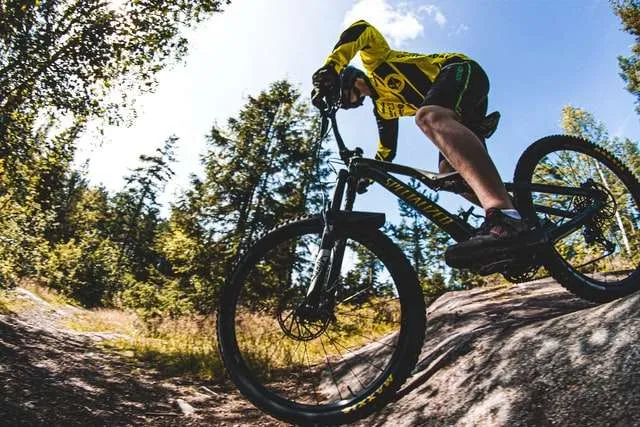
- Mountain Bikes are less aerodynamically efficient than road bikes; your body being in the upright position creates a considerable amount of air resistance.
- Mountain bikes have only one handlebar position, so it might get repetitive, and the rider might even experience hand numbness in some cases.
- Mountain bikes are less efficient than road bikes; they require more energy to get up to speed.
- Mountain bikes require more maintenance than road bikes because of the muddy, dirty and rough terrains they are ridden on.
- Mountain bikes are considerably slower than road bikes.
Differentiating Between Road Bikes And Mountain Bikes
Purpose
As we mentioned earlier, road bikes are designed to be used on all types of paved surfaces. That refers to country lanes, cycle paths, city streets, and more. They don’t perform well on rough terrain and will degrade quickly if you take it to that kind of environment. Road bikes are also designed to move quickly along a straight paved path or uphill. That’s the reason it’s shaped to improve aerodynamics.
Mountain bikes, on the other hand, are designed to be ridden off the road; they don’t perform well on streets or pavements. If you used a mountain bike to race against someone with a road bike on a paved surface, you would lose 9 times out of 10. The thick tires and heavy frame both contribute to making the mountain bike extremely slow on asphalt.
Suggested post: Find out how fast electric bikes are
Frame Geometry
Road bikes are designed to be compact and aerodynamic, while mountain bikes are designed to be sturdy and stable over rough terrain. Road bikes have a long reach and top tube. This allows the rider to be in a streamlined and aerodynamic position when cycling, and this facilitates the speed of the road bike.
Mountain bikes have a relatively short reach and top tube; this allows the handlebars to be closer to the rider for improved handling. It also enables an upright position on the bike, facilitating the balance that mountain bikes provide.
Handlebars
One of the most glaring differences between the road bike and the mountain bike is the handlebars.

Road bikes have drop bars; they are curved sets of handlebars that give three different hand positions when riding: the drops, hoods and tops. The hoods are the most frequently used position for road cycling, the drops are used for sprinting and descending, while the tops are used for climbing and riding casually.
In contrast, mountain bikes have wide and flat handlebars that extend from side to side across the front of the bike. The brake and shift levers are placed at the end of each side of the handlebar, making it easy to reach with just a finger or a thumb. Flat handlebars improve leverage and handling in tight corners.
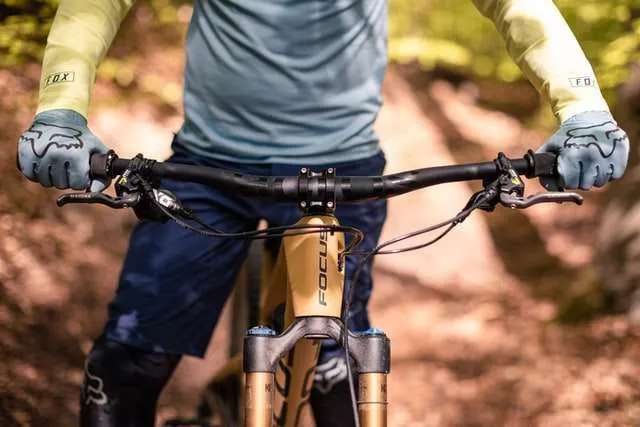
Wheels And Tires
The tires on road bikes are considerably narrower than the tires on mountain bikes. You can find road bike tires from 21mm wide, all the way to 38mm wide; this is considerably narrower than the narrowest mountain bike tire which is about 51mm wide.

Road bike tires are designed to run at much higher tire pressures than mountain bike tires; the larger size of the mountain bike tires makes them run at a lower tire pressure, leading to better performance on rough and wet terrain. The size of road bike wheels enables them to have less surface friction, leading to more speed.
Mountain bike wheels and tires are larger and wider than road bike wheels and tires, making them more reliable on rough terrain. They are designed to handle rocks, potholes and different types of obstacles.
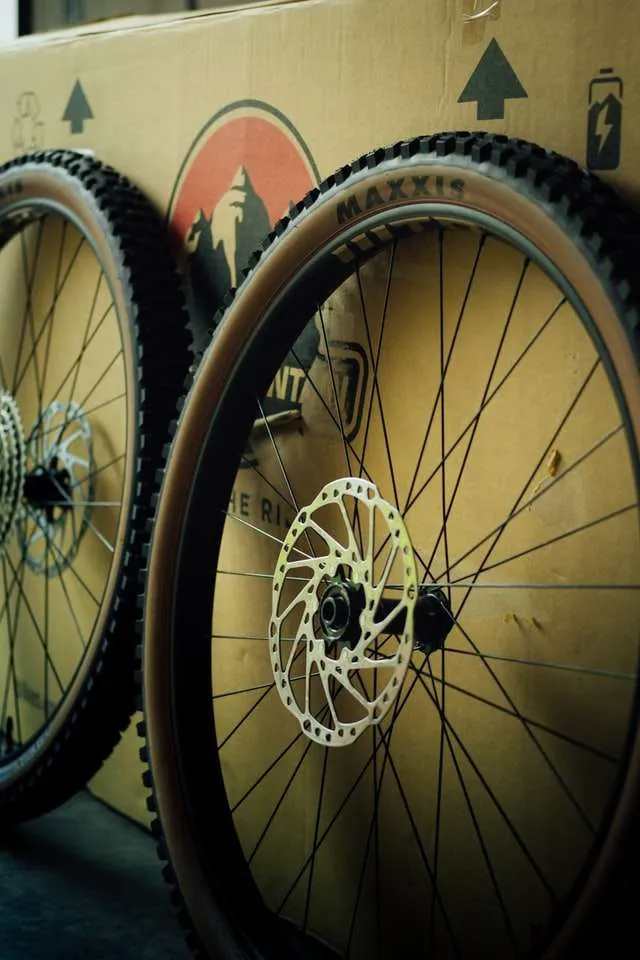
Mountain bike tires are also puncture-resistant because they come in contact with a lot of materials that would puncture an ordinary tire.
Brakes
Mountain bikes have always used big and powerful disk brakes. They have very good stopping power and perform well on wet ground; the disk brakes are definitely the best brakes for off-road biking.
Road bikes have always used rim brakes, but recently, road bike manufacturers have realized that disk brakes are more beneficial and putting them on the new models. You can still find many road bikes with rim brakes, though rim brakes are lighter and not as strong as disk brakes. Rim brakes are just generally less powerful than disk brakes and don’t perform as well when the ground is wet.
Most people who decide to buy bikes with rim brakes these days do so for convenience and affordability. Rim brake bikes are easier to service, but they aren’t as durable as disk brake bikes.
Related post: MTB in the Rain
Pedals
Both mountain bikes and road bikes have a mechanism that locks your foot on the pedal; the difference between the two is that mountain bike pedals have smaller cleats than road bike pedals, making it easier to lock.
Suspension
Suspension is one of the key points we need to talk about when discussing the differences between road bikes and mountain bikes. This is because the suspension is a feature unique to mountain bikes; you will almost never come across a road bike with suspension.
There are two types of mountain bike suspension systems:
- Hardtail suspension
- Full suspension.
Hardtail mountain bikes have suspension in the front only, and this is usually in the fork. Hardtail mountain bikes are more rigid and much lighter than full-suspension mountain bikes. This makes them ideal for short track mountain biking and cross country.
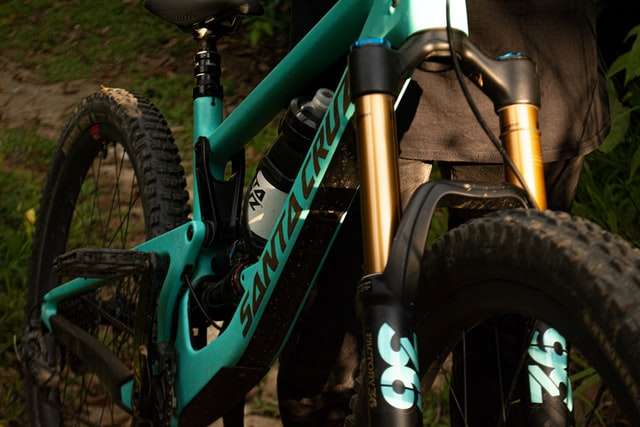
Full suspension mountain bikes have suspension in both the front and the rear, this enhances handling over rough terrain and also improves the general comfort of the bike. They are ideal for all sorts of trail riding and mountain biking.
Need a laugh? Check out our biking puns
Gearing
Mountain bikes have a 1x setup, this means that there is only one front chainring. Having one chainring decreases the chance of the chain falling off and eradicates the need for a big and pricy front derailleur. Since they have only one front chain ring and have to go through steep and challenging terrain, mountain bikes need a large gear cassette with a wide gearing range.
Some people call the cassette a ‘dinner plate’ because of its size. 11-speed and 12-speed mountain bike cassettes are now being made; this creates a huge range of gearing for single steep climbs and rapid descents.
On the other hand, road bikes have 2x setups, which means that they have two front chainrings and a front derailleur. The usual setups are 52/36, 50/34 and 53/39; the majority of road cassettes are 11-speed with a range of 11 to 28-tooth sprockets; some riders prefer bigger options to help navigate steeper climbs.
Riding Position
There is a significant difference in your body position when road biking vs mountain biking. You’ll be in an upright position on a mountain bike because of the short reach and flat handlebars. There’s a short distance between the seat and the handlebars, this allows you to hold the handlebars while sitting up. This is crucial because you need to be balanced when going through rough and bumpy terrain.

On a road bike, you’ll be stretched out, and you’ll have a forward-leaning position. This is due to the fact that there is a bigger distance between the seat and the handlebars. But endurance road bikes are different because they are built for comfort during long-distance rides, so the riding position is also more upright.
MTB vs Road Bike : Key Differences
| MTB | Road Bike | |
| Weight | Heavier | Lighter |
| Speed | Slower | Faster |
| Durability | More Durable | Less Durable |
| Riding Position | Upright | Leaning Forward |
| Average Price | Usually Less expensive | Usually More expensive |
| Suspension | Fork Suspension | None |
| Tyres | Larger | Smaller |
Mountain Bike vs Road Bike : Which should you buy?
Deciding on whether to buy a mountain bike or a road bike isn’t an easy decision to make, and it’s one that Bike Gaucho cannot make for you, but we can give you some guidelines.
Firstly, you have to consider where you live and where you will be riding the bike. If you live in the city and will be riding the bike predominantly on paved asphalt surfaces, then getting a road bike should be a no brainer; on the other hand, if you live in mountainous regions and you’re going to be riding the bike through rugged trails, then you should definitely get a mountain bike.
If you are looking for a bike that will last and will serve you for a long time, then you should be leaning towards a mountain bike, but if you are looking for a bike to race on the streets with your friends (we don’t recommend this), then you should get a road bike.
Also, if you already have a back problem, get a mountain bike, or you could get an endurance road bike. So yeah, this should give you an idea about how to go about making the dreaded ‘mountain bike vs road bike decision’.
After going through this article, you should have a decent road and mountain bike education; if you don’t, you should probably reread it. I hope you have a swell and safe time with your road/mountain bike.

